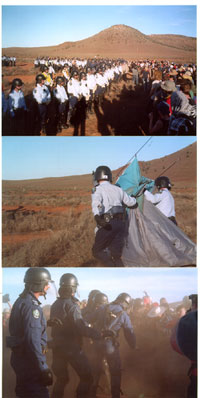|
|
ESCAPE FROM WOOMERA RESEARCH
GEMS FROM KATE'S RESEARCH FILES
Two people escaped from Baxter detention centre by climbing over the electric fences. The management claim they used rubber gloves (!) but others say ACM sometimes turn off the electric fences to save on electricity bills.
A young guy detained at the Maribyrnong centre used to escape periodically, through an air conditioning vent. He would go to the beach or shopping centre, and come back inside, up to 3 times a week.
According to DIMIA departmental records, 100 detainees escaped from the Curtain detention centre in May 1995.
In some detention centres, detainees get 'paid' around $8 for a full day's work (eg cleaning and cooking). Instead of accruing money they get 'points'. (1 pt per dollar in Woomera). Detainees can use this money to buy basic items such as cigarettes in the camp shop.
A barter economy operates in detention. Detainees trade things like cigarettes, phone cards, and pain killers.
One form of punishment used in detention is to place detainees in isolation cells. Isolation can last from hours to months. Detainees are kept in tiny cells that contain a mattress on the floor, a toilet in the corner and depending on the camp, possibly one or two surveillance cameras. Detainees have reported cases of being stripped and put into isolation naked with the air-conditioning turned up full bore.
Families are sometimes split up and put in different compounds within a centre, and even spread between different detention centres.
In Woomera, family photos were not officially allowed, and have been known to be confiscated from detainees.
DIMIA and ACM have been accused by detainees of failing to pass on faxes regarding the date of a detainee's tribunal hearings until after the date has passed.
A group of detainees were put on a plane and told they were going to Canada. They were deported to Syria.
At Baxter, ACM guards keep records of what each detainee does with their time and who they associate with. Friends are often placed in different compounds, and must apply in writing to be allowed to visit each other. It can take up to 2 weeks to be granted a visit, and detainees are driven from their separate compounds to a visiting room where they can talk together for a couple of hours.
At some stages during the operation of Woomera Detention centre, detainees were counted and asked for their number daily, sometimes in the middle of the night.
How to work out what you detainee 'number' would be if you were an asylum-seeker:
You would be given a name consisting of a three letter prefix that represents the boat you came to Australia on and then a number to distinguish you among other asylum-seekers from that boat. If you didn't arrive by boat your prefix would be 'NBP - Non Boat Person'.
Medications commonly prescribed in Woomera:
Zoloft (anti-depressant), Celebrex, Fluvoxamine, Tomazapan.
The isolation block at Curtin was called "The Hilton".
Villawood detainees often refer to their detention centre as "The Villawood Ritz".
A minority of 'kind' guards at the centres have been known to bring sweets in for the children.
|



Images from Kate's research trip to Baxter
|
|
|
copyleftescapefromwoomera.org
|
|
 In Woomera, detainees weren't addressed by name, but by number.
In Woomera, detainees weren't addressed by name, but by number.
“Every story-telling medium in the history of mankind has included violent themes, because we depend on stories to help us sort through our conflicting values and our mixed feelings about aggression…What is bad about a lot of games isn’t that they are violent but that they trivialize violence.”
– Henry Jenkins, director of comparative media studies, MIT
|
|

